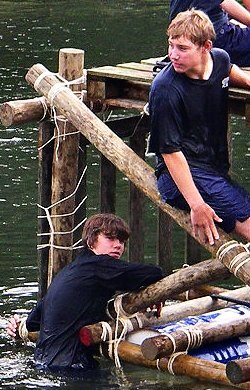Rafting
Traditional rafting is about paddling along on a raft made from wooden poles, rope, and barrels.
People have build rafts for hundreds of years. The basic design involves tying things together to create a floating platform. They’re simple crafts, so you’ll need to paddle a bit differently compared to how you’d paddle something like a canoe. Modern crafts often use sealed barrels or polystyrene blocks to help them float.
Rafting is a great way to try something new. Traditional rafts are very different to other crafts. It’s also a true test of teamwork, as you’ll all need to play your part to get the raft moving in the right direction.
The best pioneering projects are the ones that are plenty of fun. Rafting is about putting your knotting skills to the test and trusting your teammates’ techniques. After all, if it all falls apart, you’ll be the ones getting wet!
Handy Hints
Give it a go in the warm (and dry).
Before you put your trust in a raft to carry you across the water,
why not practise on a smaller scale?
Tiny twig rafts are the perfect way to learn how to make a raft before your wet adventure.
Clothing: Be Prepared To Get Wet
Everyone should be able to swim 50m in the required clothing for this activity. Non-swimmers will need additional support, including an opportunity to go into the water fully clothed and float with a lifevest.
Don’t wear your best clothes, they will get very wet. While building the raft, you're in the water quite often.
Don’t wear your best shoes. When you sit on the raft, your feet will probably be in the water. As with your clothes, whatever you’re wearing on your feet will get very soggy. It’s best to wear an old pair of shoes, and bring spare shoes and clothes to get you home.

A warm pullover with jeans and robust footwear is a good start.

Safety Tips
- Complete a risk assessment
- Everyone must wear a life jacket or bouyancy aid.
- Know what to do in an emergency
- Check the weather forecast
- Use a waterways directory to check the water category.
- Make sure that all equipment is fit for purpose and in good condition. The instructor must make sure boats are seaworthy
Practise Your Knots
You often build your own raft before setting out on the water,
so practise those knots and lashings.
A raft is only as strong as its weakest knot.
Before you put your skills to the test,
make sure you know how to keep your raft shipshape.
Scout publictions often contain a great guide to lashings.
Once you’ve learned the basics,
make practising fun with games like "Knot a Race" or "To Eat or Knot to Eat".
Reflection
Building (and paddling) a traditional raft relies on everyone playing their part. In the most successful teams, everyone has an important job to do. Did different people have different roles to keep the raft afloat and moving in the right direction? Did people have favourite (or least favourite) jobs?
How did people’s teams work?
Did everyone just get on with their jobs separately,
or did they keep chatting and checking in with each other?
The most successful team players put themselves in their teammates shoes
so they can offer a helping hand and ask for help when they need it.
Did anyone stand out as a great leader?
How did they help everyone to make or paddle the raft?
Did everyone get a chance to get soaking wet?